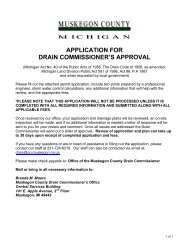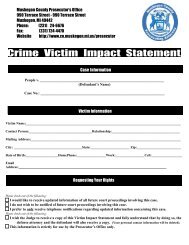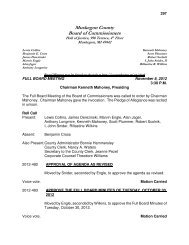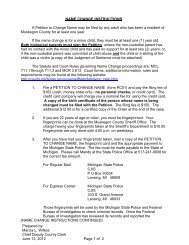PDF - Muskegon County
PDF - Muskegon County
PDF - Muskegon County
Create successful ePaper yourself
Turn your PDF publications into a flip-book with our unique Google optimized e-Paper software.
THE HISTORY OF MUSKEGON COUNTY<br />
(Written 2009)<br />
The name “<strong>Muskegon</strong>” is derived from the Ottawa Indian term<br />
“Masquigon” meaning “marshy river” or “swamp,” in reference to both the<br />
river and the lake. But the name does not do justice to the area or the<br />
people who have come to live here. Located along Michigan’s west coast,<br />
<strong>Muskegon</strong> is a land of windswept sand dunes, naturally impounded rivers<br />
with natural harbors for shipping and recreation, an abundance of natural<br />
resources, a temperate climate, and potential for tremendous growth.<br />
During the early historic era, <strong>Muskegon</strong> was inhabited by various bands<br />
of semi-nomadic Ottawa and Pottawatomi Indians. Perhaps the best<br />
remembered of the historic Indian inhabitants of this area was the noted<br />
Ottawa chieftain, Pendelouan. He and his people lived in the vicinity of<br />
<strong>Muskegon</strong> Lake in the 1730s and 1740s, until induced by the French to<br />
move their settlement to the Traverse Bay area in 1742.<br />
No one knows for certain when the first Frenchman visited the <strong>Muskegon</strong><br />
area, but we do know that Father Jacques Marquette traveled northward<br />
through this area on his fateful trip to St. Ignace in 1675, and a party of<br />
French soldiers under La Salle’s lieutenant, Henry de Tonty, passed<br />
through this area in 1679. If the French established trading posts in this<br />
vicinity, their locations are not known.<br />
The earliest identifiable white resident of the county was Edward Fitzgerald,<br />
a fur trader and trapper, who visited the <strong>Muskegon</strong> area in 1748 and who<br />
died here, reportedly being buried in the vicinity of White Lake. Sometime<br />
between 1790 and 1800 a French-Canadian fur trader named Joseph La<br />
Framboise built a trading post at the mouth of Duck Lake, one of a string<br />
of trading posts he maintained along the West Michigan coast. Between<br />
1810 and 1820 several French Canadian fur traders, including Lamarandie,<br />
Jean Baptiste Recollect, and Pierre Constant, built posts along the shores<br />
of <strong>Muskegon</strong> Lake.<br />
The political history of <strong>Muskegon</strong> began in 1837 when <strong>Muskegon</strong> Township<br />
was organized as a sub-division of Ottawa <strong>County</strong>. One of the earliest<br />
settlers, Henry Pennoyer, was elected the first township supervisor in<br />
1938. As a corporate entity, <strong>Muskegon</strong> <strong>County</strong> dates from 1859. Prior to<br />
that time the southern three-quarters of the county were attached to<br />
Ottawa <strong>County</strong>, while the northern quarter belonged to Oceana <strong>County</strong>.<br />
At the time of the county’s creation, in 1859, the county was divided into<br />
six townships, <strong>Muskegon</strong>, Norton, Ravenna, White River, Dalton, and<br />
Oceana, with a total population of 3,947.<br />
Political development of the area coincided with the start of the lumbering<br />
era. The local lumber industry commenced in 1837 with the construction<br />
of three small sawmills on the south side of <strong>Muskegon</strong> Lake and another<br />
sawmill near the mouth of the White River. The first wave of lumbermen<br />
included Charles Mears, Martin Ryerson, Lyman Mason, Charles Hills,<br />
George and John Ruddiman, and the members of the Ferry family. By the<br />
time the <strong>Muskegon</strong> lumber industry reached its peak in the mid-1880s, 47<br />
sawmills surrounded <strong>Muskegon</strong> Lake, while another 16 dotted the shores<br />
of White Lake to the north. <strong>Muskegon</strong> was then known as the “Lumber<br />
Queen of the West.” The population consisted of native-born migrants<br />
from the Northeastern states, plus immigrants from Canada, the British<br />
Isles, Scandinavia, Germany, and the Netherlands.<br />
8
















